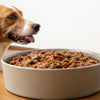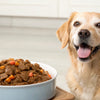Is Wet Dog Food Bad? Understanding the Pros and Cons for Your Pup
- Houndsy
Table of Contents
- Introduction
- What Is Wet Dog Food?
- Nutritional Comparison: Wet vs. Dry Dog Food
- Potential Drawbacks of Wet Dog Food
- Is Wet Dog Food Bad for Dental Health?
- Where Wet Dog Food Shines
- Mixing Wet and Dry Dog Food: Finding Balance
- The Houndsy Approach: Elevating Dog Feeding Rituals
- Conclusion
- FAQs
Introduction
Have you ever found yourself staring at the dog food aisle, overwhelmed by the plethora of options? You’re not alone. According to a recent survey, over 60% of dog owners express confusion about the best diet for their furry friends. One major decision they face is whether to feed their dogs wet or dry food. Today, we’re diving deep into this topic to answer the burning question: is wet dog food bad for dogs?
In this blog post, we aim to give you a thorough understanding of wet dog food—its benefits, potential drawbacks, and its suitability for various types of dogs. We'll explore how wet food impacts hydration, palatability, and overall dog health, as well as how to choose the right type of food for your canine companion.
By the end of this post, you’ll have a comprehensive sense of whether wet food could be a viable option or if it's better to stick to dry kibble. Whether you're a new dog owner or you’ve had furry companions for years, we invite you to reflect on your feeding choices and learn how Houndsy can simplify and elevate your pet’s feeding experience with our innovative Houndsy Kibble Dispenser.
What Is Wet Dog Food?
Wet dog food, also known as canned dog food, typically contains up to 84% water, making it much more hydrating than its dry counterpart. It comes in various forms such as pâté, chunks in gravy, and stews. The softer texture helps appeal to many dogs' palates, and it's easier for pets with dental issues to chew.
How Is Wet Dog Food Made?
Wet dog food starts with high-quality protein sources, which are ground into a mixture. This is combined with other essential nutrients—vitamins, minerals, and grains—before being sealed in a can and cooked to ensure safety and freshness. The process allows for a longer shelf life compared to homemade options while maintaining nutritional value.
Key Ingredients to Look For:
- Meat or meat meal as the main ingredient
- Healthy fats for energy
- Whole grains or vegetables for fiber and vitamins
Nutritional Comparison: Wet vs. Dry Dog Food
Key Differences in Nutritional Content
When considering whether wet dog food is bad for dogs, it’s essential to look at its nutritional makeup compared to dry food. Here’s a quick breakdown:
Wet Dog Food:
- Moisture Content: High (up to 84%)
- Protein Levels: Often higher in protein
- Fat Levels: Can contain higher fat content
- Carbohydrates: Usually lower in carbohydrates
- Appeal: Enhanced aroma and flavor
Dry Dog Food:
- Moisture Content: Low (around 10%)
- Protein Levels: Varies by brand (read labels!)
- Fat Levels: Tends to be lower
- Carbohydrates: Higher, particularly in certain brands
- Convenience: Easier to measure and store
Benefits of Wet Dog Food
-
Higher Moisture Intake: One of the primary benefits of wet food is its high moisture content, which can encourage hydration—especially in dogs that don't drink enough water.
-
Palatability: Canned food is often more enticing for dogs due to its aroma and flavor. If you have a picky eater, they may prefer wet food over dry kibble.
-
Easier to Chew: Wet food is generally softer, making it easier to chew for puppies, seniors, or dogs with dental problems.
-
Satiety: The high moisture content can help dogs feel fuller longer, which may assist in weight management.
Potential Drawbacks of Wet Dog Food
-
Dental Health: Wet food doesn’t have the same scrubbing action on teeth as dry kibble, which can lead to tartar buildup if dental care isn’t maintained.
-
Spoilage: Once opened, cans of wet food need to be refrigerated and consumed within a few days to prevent spoilage.
-
Cost Efficiency: Generally speaking, wet food is more expensive per calorie than dry food, especially if you’re feeding it exclusively.
-
Waste Generation: Canned food packaging can create more waste compared to dry food, raising sustainability concerns.
Is Wet Dog Food Bad for Dental Health?
While the nutritional value of wet dog food can be excellent, one concern that often arises is its impact on dental health. Research shows that while wet food may not be the best for keeping teeth clean, it’s not necessarily harmful if paired with a good dental care routine. Regular vet check-ups, dental chews, and brushing can mitigate the downsides.
Where Wet Dog Food Shines
Let's take a closer look at cases where wet dog food can be particularly beneficial:
1. Puppies and Nursing Dogs
Wet food is advantageous for puppies transitioning from milk to solid food due to its softer formulation, which is easier for their tiny, developing teeth. Additionally, nursing dogs can benefit from the higher caloric density of wet food.
2. Senior Dogs with Health Issues
Older dogs may struggle with dental and chewing challenges. Wet food's softer texture allows them to eat comfortably. Additionally, dogs with specific health issues, like kidney disease, can benefit from the hydration that wet food provides.
3. Dogs with Reduced Appetite
For dogs recovering from illness or surgery who may have diminished interest in food, the enticing smell and flavor of wet food can encourage them to eat more regularly.
Mixing Wet and Dry Dog Food: Finding Balance
If you’re still unsure whether wet dog food is bad, many pet owners find success mixing wet and dry dog food. This approach can provide a more balanced feeding experience; the moisture from wet food complements the dental benefits of dry kibble.
When mixing diets, it’s essential to ensure that the overall caloric intake aligns with your dog’s dietary needs. Consulting your vet can help you formulate the best approach.
The Houndsy Approach: Elevating Dog Feeding Rituals
At Houndsy, we recognize the importance of creating an enjoyable and seamless feeding experience for you and your pet. Our flagship product, the Houndsy Kibble Dispenser, is designed to simplify your dog feeding routine with perfect portion control and ergonomic convenience.
Why Choose Houndsy?
- Convenient Crank Operation: Our dispenser features an easy-to-use crank at standing height, eliminating the need for bending and making the feeding ritual more enjoyable.
- Mid-Century Modern Design: Not only does it prioritize functionality, but it fits beautifully into your home decor.
- High-Quality Materials: Built with BPA-free liners to ensure food freshness and durability.
- Large Capacity: With a storage capacity for 25–30 lbs, you'll reduce the frequency of food purchasing.
Embrace a hassle-free dog feeding experience—check out our Houndsy Kibble Dispenser today!
Conclusion
So, is wet dog food bad? The answer isn't as simple as yes or no; rather, it depends on several factors, including your dog's individual needs and overall diet. Both wet and dry dog foods have their unique benefits and drawbacks. The key is to evaluate your dog's specific health, preferences, and lifestyle to make an informed decision.
Ultimately, high-quality wet dog food can be a valuable part of your pup's diet—offering hydration, palatability, and ease of consumption, especially for puppies and seniors. Don’t forget to maintain a good dental hygiene routine and consult your vet for personalized advice.
As we reflect on our own feeding routines, let’s also explore how innovative solutions like the Houndsy Kibble Dispenser can enhance your pet care experience. Begin your journey to a better feeding ritual today!
FAQs
Is wet dog food safe? Yes, wet dog food is safe as long as it meets nutritional standards and is fed in appropriate amounts.
Can I feed my dog only wet food? Yes, many dogs thrive on exclusively wet food diets, especially if they are properly balanced.
Does wet food make dogs gain weight? Not necessarily. It’s often lower in carbohydrates compared to dry food. However, caloric content and quality matter; choose high-quality wet food to avoid excessive fat intake.
How can I transition my dog to wet food? Gradually mix wet food with their current dry food, increasing the wet amount over several days to avoid digestive upset.
Is it better for dogs to eat wet food in moderation? Moderation is key. While wet food has great benefits, balance it with dry food to support dental health and control calorie intake.
For a convenient and elegant feeding solution, explore our Houndsy Kibble Dispenser and transform your dog’s feeding ritual today!












